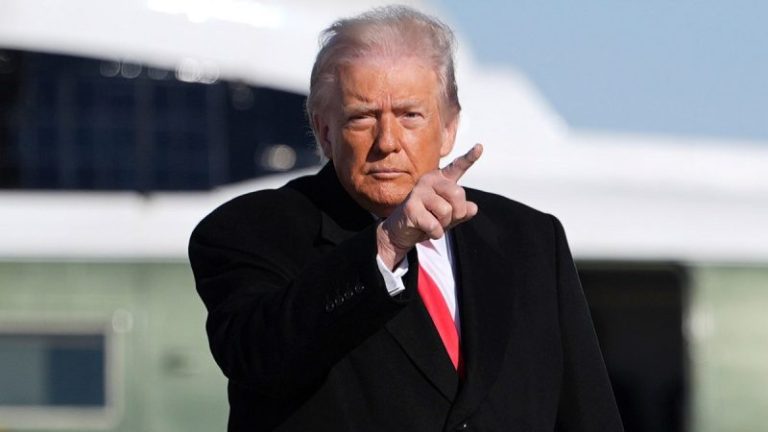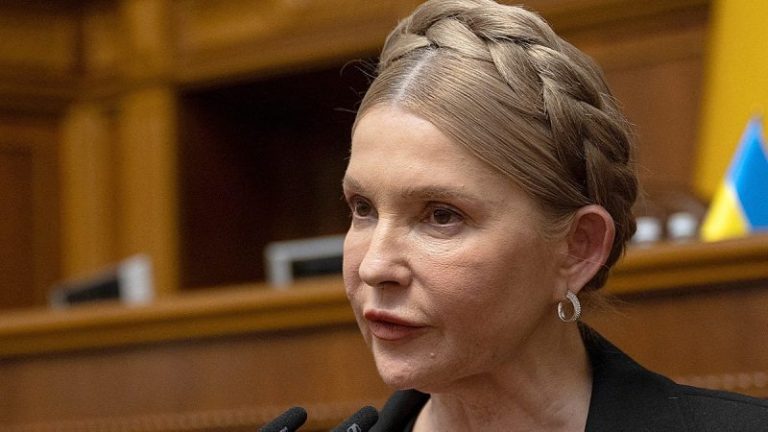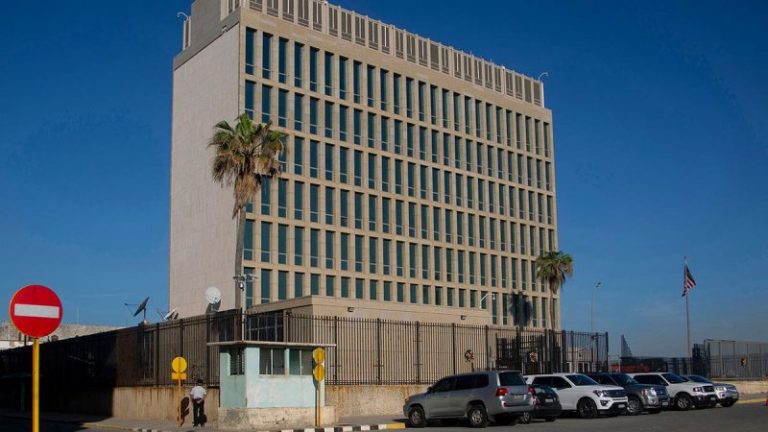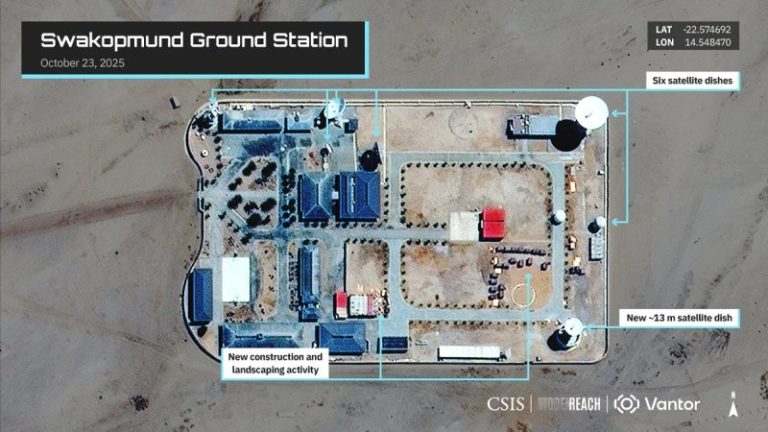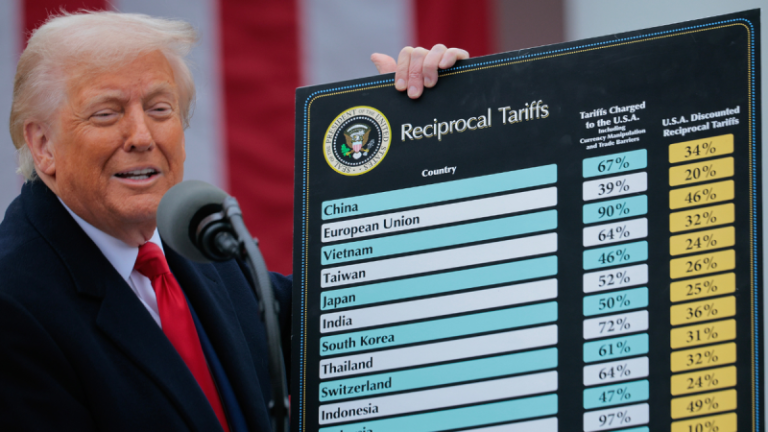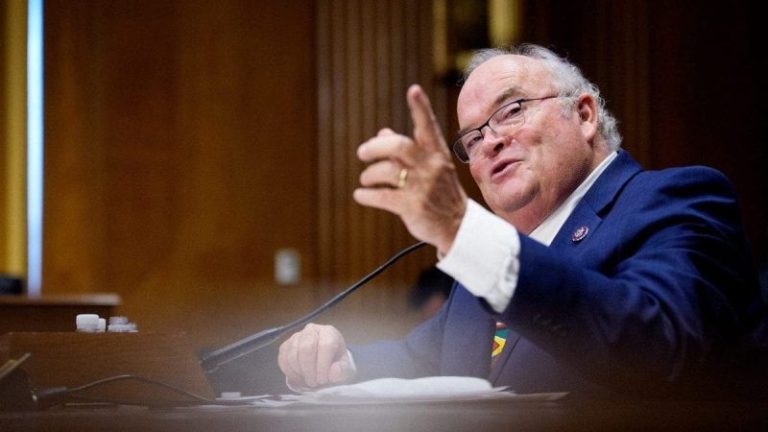American Eagle Gold Corp. (TSXV: AE) (‘American Eagle’ or the ‘Company’) is pleased to announce drill results that further expand the South Zone at its NAK copper-gold project in British Columbia. Holes NAK25-55 and NAK25-62 extend shallow mineralization nearly 150 meters east-southeast, while NAK25-69 and NAK25-72 expand it 150 meters to the west-southwest. Notably, NAK25-55 and -62 highlight near-surface mineralization along the southern edge of the Babine porphyry stock shown in Figure 1. Additionally, Figure 2 highlights the South Zone growth achieved through the drill results presented in this release.
Highlights:
- NAK25-62: Extended near-surface mineralization 150 m east of NAK25-46, intersecting 140 m of 0.74% CuEq within 189 m of 0.61% CuEq starting near surface.
- NAK25-55: Extended near-surface mineralization 150 m south of NAK25-62, intersecting 134 m of 0.40% CuEq starting near surface.
- NAK25-69: Extended mineralization 150 m south of NAK25-41, intersecting 130 m of 0.62% CuEq within 409 m of 0.33% CuEq starting 215 m downhole.
- NAK25-72: Further westward extension of NAK25-69 drilled from the same location at a shallower inclination, intersecting 455 m of 0.31% CuEq starting 166 m downhole.
Strategic Importance of the South Zone:
The South Zone is characterized by strong grades, shallow mineralization, and minimal overburden, making it a logical focus for continued step-out and infill drilling. This area has the potential to support early-stage development scenarios while providing optionality for bulk mining approaches in adjacent, yet-to-be-defined zones across the NAK project.
With these latest results, the South Zones dimensions extend over 700 m in the east-west direction, 500 m in the north-south direction, and to over 800 m in depth. The holes in this release have contributed a high-confidence expansion of over 150 m in both the east-west and north-south dimensions from the previous iteration of the model, and a substantial increase over the previous seasons of drilling (see Figure 3). Strong potential for expansion remains along the southern margin of the Babine Porphyry stock, where the Company has completed additional widely spaced step-out drilling, within a 1 km trend of open, highly prospective ground, extending eastward from the currently modeled bounds of the zone (see Figure 4).
‘These results reinforce the South Zone as the focus of our drilling program, yet they also highlight that it sits within what is clearly an exceptionally large and continuous copper-gold system at NAK that exists far beyond what is the South Zone. The consistent near-surface mineralization and significant step-out extensions in multiple directions confirm both the scale and the potential of NAK,’ said Anthony Moreau, CEO of American Eagle Gold Corp.
View Interactive 2D Map of NAK
View Core Photos for Released Holes
Watch: Webinar with Anthony Moreau and Neil Prows Discussing Significance of January 15 Results
NAK25-62 Assay Results (Table 1) and Details*
| Hole |
From |
To |
Length |
Cu % |
Au g/t |
Ag g/t |
Mo ppm |
CuEq % |
| NAK25-62 |
124 |
264 |
140 |
0.28 |
0.35 |
1.2 |
100 |
0.74 |
| Within |
|
|
|
|
|
|
|
|
| NAK25-62 |
75 |
264 |
189 |
0.23 |
0.28 |
1.1 |
90 |
0.61 |
| And |
|
|
|
|
|
|
|
|
| NAK25-62 |
483 |
701 |
218 |
0.17 |
0.15 |
0.4 |
49 |
0.37 |
| Within |
|
|
|
|
|
|
|
|
| NAK25-62 |
32 |
827 |
795 |
0.13 |
0.12 |
0.5 |
51 |
0.30 |
View Clean Cross Section l View Combined Hole Cross Section l View Hole Location
* Copper Equivalent (CuEq) shown in Tables for drill intercepts are calculated on the basis of US$ 4.50/lb for Cu, US$ 3,375/oz for Au, US$ 60/oz for Ag and US$ 25/lb for Mo, with 80% metallurgical recoveries assumed for all metals (since it’s unclear what metals will be the principal products, assuming different recoveries is premature at this stage). The formula is: CuEq. = Cu % + (Au grade in g/t x (Au recovery / Cu recovery) x [Au price ÷ 31] / [Cu price x 2200 x 1%]) + (Ag grade in g/t x (Ag recovery / Cu recovery) x [Ag price ÷ 31] / [Cu price x 2200 x 1%] + (Mo grade in % x (Mo recovery / Cu recovery) x [Mo price] / [Cu price]). The assays have not been capped.
NAK25-62 was collared approximately 150 m to the east of NAK25-46 and drilled steeply to the west. This hole was designed to expand the known extent of South Zone mineralization to the east of the tested zone. NAK25-62 collared into interbedded siltstone, sandstone, and conglomerate, before transitioning into a well mineralized package of sandstone at a depth of 75 m. Concordant with the Company’s modelling, mineralization, consisting of disseminated and vein hosted chalcopyrite remained strong to a depth of 264 m, where the hole transitioned to a thinly bedded, less well mineralized package of fine-grained sedimentary rock. Disseminated chalcopyrite mineralization abruptly increases in abundance below this unit, at a depth of 480 m, coinciding with a transition to the well constrained mineralized conglomerate. As the hole traversed deeper, sulfide speciation gradually shifted to pyrite/pyrrhotite dominant, bottoming in concretion-bearing fine sandstone cut by narrow mafic dyking.
NAK25-55 Assay Results (Table 2) and Details*
| Hole |
From |
To |
Length |
Cu % |
Au g/t |
Ag g/t |
Mo ppm |
CuEq % |
| NAK25-55 |
97 |
231 |
134 |
0.13 |
0.21 |
1.3 |
14 |
0.40 |
| And |
|
|
|
|
|
|
|
|
| NAK25-55 |
503 |
808 |
305 |
0.12 |
0.07 |
0.5 |
60 |
0.23 |
| Within |
|
|
|
|
|
|
|
|
| NAK25-55 |
119 |
884 |
765 |
0.09 |
0.07 |
0.6 |
40 |
0.21 |
View Cross Section l View Hole Location
NAK25-55 was collared approximately 150 m south-southeast of NAK25-62 and drilled steeply to the west-northwest. The hole was designed to test both near surface and deep mineralization beyond the southeastern extent of drilling in the South Zone. The hole collared into interbedded sandstone and siltstone with subordinate lenses of conglomerate, to a depth of 300 m, where the hole’s first instance of fine grained mafic intrusive was encountered. The mafic unit continued to a depth of 400 m, where the hole transitioned into sparsely feldspar phyric porphyry dyking followed by conglomerate. Conglomerate predominated to a depth of 600 m, where thin beds of sandstone were interspersed with numerous intervals of fine grained mafic intrusive rock, which remained the dominant lithology to end of hole. Mineralization in NAK25-55 consisted of sparse chalcopyrite disseminations and stringers, primarily confined to sandstone and conglomerate lithologies, with local punctuations of vein hosted bornite confined to narrow zones within the lower intercept of mafic dyking.
NAK25-69 Assay Results (Table 3) and Details*
| Hole |
From |
To |
Length |
Cu % |
Au g/t |
Ag g/t |
Mo ppm |
CuEq % |
| NAK25-69 |
452 |
582 |
130 |
0.32 |
0.16 |
1.0 |
175 |
0.62 |
| Within |
|
|
|
|
|
|
|
|
| NAK25-69 |
215 |
624 |
409 |
0.18 |
0.08 |
0.8 |
77 |
0.33 |
| Within |
|
|
|
|
|
|
|
|
| NAK25-69 |
13 |
787 |
774 |
0.13 |
0.05 |
0.6 |
62 |
0.23 |
View Cross Section l View Hole Location
NAK25-69 was collared from the same location as NAK25-49, and drilled steeply to the west. This hole was designed to test the southern limits of mineralization, approximately 100 m south of the stronger than anticipated mineralization encountered in NAK25-41. The hole collared into interbedded sandstone and siltstone interspersed with thin beds of conglomerate, before entering dominantly conglomerate units at a depth of 175 m. The hole remained in conglomerate, cut by numerous instances of compositionally and texturally variable porphyry dyking, to a depth of 450 m, where interbedded fine to coarse sandstone prevailed as the dominant lithology. Mineralization in NAK25-69 was characterized by broad zones of low to moderate grade, represented by sparsely distributed chalcopyrite bearing quartz-anhydrite veins and sparse chalcopyrite disseminations, punctuated by shorter intervals of stronger grade, associated with bornite and dense chalcopyrite mineralization. The strongest zones of mineralization are commonly associated with the presence of porphyry dyking, notably between 452 and 582 m, where the dykes themselves host abundant chalcopyrite and bornite disseminations.
NAK25-72 Assay Results (Table 4) and Details*
| Hole |
From |
To |
Length |
Cu ppm |
Au g/t |
Ag g/t |
Mo ppm |
CuEq % |
| NAK25-72 |
166 |
245 |
79 |
0.28 |
0.11 |
1.3 |
217 |
0.54 |
| And |
|
|
|
|
|
|
|
|
| NAK25-72 |
416 |
570 |
154 |
0.27 |
0.08 |
1.6 |
72 |
0.42 |
| Within |
|
|
|
|
|
|
|
|
| NAK25-72 |
166 |
621 |
455 |
0.18 |
0.06 |
1.0 |
72 |
0.31 |
View Cross Section l View Hole Location
NAK25-72 was collared from the same location as NAK25-69 and drilled shallowly to the west, designed to test westward from the encouraging mineralization encountered previously in the steeper oriented NAK25-69. The hole collared into interbedded sandstone and siltstone, transitioning to conglomerate at a depth of 75 m. Conglomerate predominated to a depth of 350 m, succeeded by fine to coarse grained sandstone for the remainder of the hole. As with NAK25-69, mineralization was characterized by broad intervals of low grade disseminated chalcopyrite, punctuated by zones of vein hosted bornite and densely disseminated chalcopyrite mineralization commonly within and enveloping porphyry dykes of variable composition. Sulfide speciation within the disseminated mineralization transitions from chalcopyrite dominant to pyrite-pyrrhotite dominant, as the hole traverses farther to the west, with local zones of chalcopyrite dominant sporadically throughout.
NAK25-65 Assay Results (Table 5) and Details*
| Hole |
From |
To |
Length |
Cu % |
Au g/t |
Ag g/t |
Mo ppm |
CuEq % |
| NAK25-65 |
211 |
339 |
128 |
0.18 |
0.05 |
0.8 |
23 |
0.26 |
| Within |
|
|
|
|
|
|
|
|
| NAK25-65 |
7 |
575 |
568 |
0.09 |
0.03 |
0.6 |
20 |
0.15 |
View Cross Section l View Hole Location
NAK25-65 was collared approximately 120 m west-southwest of NAK25072/69, designed to test the southwestern limits of known South Zone mineralization. This hole encountered a similar association of interbedded coarse to fine sedimentary rocks, transitioning to conglomerate, and finally sandstone, as described above in NAK25-72 and 69. Similarly to NAK25-72, the best mineralization was strongly associated with narrow intervals of feldspar phyric porphyry dyking, intruding weakly mineralized sedimentary host rocks. Sulfide speciation within the sedimentary units transitions from chalcopyrite-pyrite to pyrite dominant as the hole traversed farther to the west, and consistent with drilling elsewhere at NAK, the hole was terminated when pyrite was observed to be the dominant disseminated sulfide.
Collar details for holes in this release (table 6):
| Hole |
UTM_Grid |
UTM_East |
UTM_North |
Azimuth |
Inclination |
TD (m) |
| NAK25-55 |
NAD83_Z9 |
675620 |
6129124 |
280 |
-75 |
884 |
| NAK25-62 |
NAD83_Z9 |
675575 |
6129266 |
265 |
-75 |
827 |
| NAK25-65 |
NAD83_Z9 |
675191 |
6129109 |
265 |
-50 |
575 |
| NAK25-69 |
NAD83_Z9 |
675297 |
6129153 |
255 |
-75 |
787 |
| NAK25-72 |
NAD83_Z9 |
675297 |
6129153 |
255 |
-55 |
621 |
QA/QC and Sampling Protocol
Sampling at NAK follows a rigorous methodology and internal QA/QC protocol. Drill core is halved on site, and samples are submitted to ALS Geochemistry in Langley, British Columbia for preparation and analysis. ALS is accredited to the ISO/IEC 17025 standard for assays. All analytical methods include quality control standards inserted at set frequencies. The entire sample interval is crushed and homogenized, and 250 g of the homogenized sample is pulped. All samples were analyzed for gold, silver, copper, molybdenum and a suite of 45 other major and trace elements. Analysis for gold is by fire assay fusion followed by Inductively Coupled Plasma Atomic Emission Spectroscopy (ICP-AES) on 30 g of pulp. Analysis for silver, copper, and molybdenum and all other major and trace elements are analyzed by four-acid digestion followed by Inductively Coupled Plasma Mass Spectroscopy (ICP-MS).
Internal QA/QC protocols dictate that individual core samples are no less than 70 cm and no greater than 3 m in length. To control standard, blank, and duplicate sample frequency, and to better constrain pass/fail re-analysis intervals, samples are submitted to the lab in 50 sample batches. Within each 50-sample batch, there is one gold-copper standard and two coarse reject duplicates, inserted at regular intervals, and two blank samples, inserted sequentially following well-mineralized samples where possible, for a total of 10% QA/QC samples. All gold and copper standard analyses from the 2024 program passed within 3 standard deviations of expected values. Where duplicate values differed significantly, the lower values from the resulting re-analyses were used.
About American Eagle’s NAK Project
The NAK Project lies within the Babine copper-gold porphyry district of central British Columbia. It has excellent infrastructure through all-season roads and is close to the towns of Smithers, Houston, and Burns Lake, B.C., which lie along a major rail line and Provincial Highway 16. Historical drilling and geophysical, geological, and geochemical work at NAK, which began in the 1960’s, tested only to shallow depths. Still, the work revealed a very large near-surface copper-gold system that measures over 1.5 km x 1.5 km. Drilling completed by American Eagle in 2022, 2023, and 2024 returned significant intervals of high-grade copper-gold mineralization that reached beyond and much deeper than the historical drilling, indicating that zones of near-surface and deeper mineralization, locally with considerably higher grades, exist within the broader NAK property mineralizing system. Drilling is currently in progress, with over 16,500 metres drilled across 26 holes out of the planned 30,000-metre drill program. Three drills are actively operating, including one helicopter-supported hole, and expected to continue into December.
For the latest videos from American Eagle, Ore Group, and all things mining, subscribe to our YouTube Channel: youtube.com/@theoregroup
About American Eagle Gold Corp.
American Eagle is dedicated to advancing its NAK copper-gold porphyry project in west-central British Columbia, Canada. The Company benefits from over $36 million in cash, bolstered by two strategic investors formed in the past two years with Teck Resources and South32. With substantial financial and technical resources, American Eagle Gold is well-positioned to drill, de-risk, and define the full potential of the NAK Copper-Gold porphyry project.
Anthony Moreau, Chief Executive Officer
416.644.1567
amoreau@oregroup.ca
www.americaneaglegold.ca
Q.P. Statement
Mark Bradley, B.Sc., M.Sc., P.Geo., a Certified Professional Geologist and independent ‘qualified person’ for the purposes of Canada’s National Instrument 43-101 Standards of Disclosure for Mineral Properties, has verified and approved the information contained in this news release.
Forward-Looking Statements
Certain information in this press release may contain forward-looking statements. Forward-looking statements in this press release include, but are not limited to: including statements relating to the use of proceeds of the Offering, the tax treatment of the Charity FT Shares, the receipt of all necessary regulatory approvals in connection with the Offering, the 2025 drill program or its anticipated results at the Company’s NAK project, the ability of the Company to make the Qualifying Expenditures as anticipated by management, and other matters ancillary or incidental to the foregoing. This information is based on current expectations that are subject to significant risks and uncertainties that are difficult to predict. Therefore, actual results might differ materially from those suggested in forward-looking statements. American Eagle Gold Corp. assumes no obligation to update the forward-looking statements or to update the reasons why actual results could differ from those reflected in the forward-looking statements unless and until required by securities laws applicable to American Eagle Gold Corp. Additional information identifying risks and uncertainties is contained in filings by American Eagle Gold Corp. with Canadian securities regulators, which filings are available under American Eagle Gold Corp. profile at www.sedarplus.ca.
Neither TSX Venture Exchange nor its Regulation Services Provider (as that term is defined in the TSX Venture Exchange policies) accept responsibility for the adequacy or accuracy of this release.
Source
This post appeared first on investingnews.com

